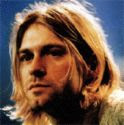Early Development
A seminal release in the development of grunge was 1986's Deep Six compilation, released by C/Z Records (later reissued on A&M). The record featured multiple tracks by six bands: Green River, Soundgarden, The Melvins, Malfunkshun, Skin Yard, and The U-Men. For many of them it was their first appearance on record. The artists had "a mostly heavy, aggressive sound that melded the slower tempos of heavy metal with the intensity of hardcore." As Jack Endino recalled, "People just said, 'Well, what kind of music is this? This isn't metal, it's not punk, What is it?' People went 'Eureka! These bands all have something in common.'"
Later that year Bruce Pavitt released the Sub Pop 100 compilation and Green River's Dry As a Bone EP as part of his new label, Sub Pop. An early Sub Pop catalog described the Green River EP as "ultra-loose GRUNGE that destroyed the morals of a generation." Sub Pop's Bruce Pavitt and Jonathan Poneman, inspired by other regional music scenes in music history, worked to ensure that their label projected a "Seattle sound," reinforced by a similar style of production and album packaging. While music writer Michael Azerrad acknowledged that early grunge bands like Mudhoney, Soundgarden, and Tad had disparate sounds, he noted "to the objective observer, there were some distinct similarities." Early grunge concerts were sparsely attended (many by fewer than a dozen people) but Sub Pop photographer Charles Peterson's pictures helped create the impression that such concerts were major events. Mudhoney, which was formed by former members of Green River, served as the flagship band of Sub Pop during their entire time with the label and spearheaded the Seattle grunge movement. Other record labels in the Pacific Northwest that helped promote grunge included C/Z Records, Estrus Records, EMpTy Records and PopLlama Records.
Grunge attracted media attention in the United Kingdom after Pavitt and Poneman asked journalist Everett True from the British magazine Melody Maker to write an article on the local music scene. This exposure helped to make grunge known outside of the local area during the late 1980s and drew more people to local shows. The appeal of grunge to the music press was that it "promised the return to a notion of a regional, authorial vision for American rock." Grunge's popularity in the underground music scene was such that bands began to move to Seattle and approximate the look and sound of the original grunge bands. Mudhoney's Steve Turner said, "It was really bad. Pretend bands were popping up here, things weren't coming from where we were coming from." As a reaction, many grunge bands diversified their sound, with Nirvana and Tad in particular creating more melodic songs. Heather Dawn of the Seattle fanzine Backlash recalled that by 1990 many locals had tired of the hype surrounding the Seattle scene and hoped that media exposure had dissipated.
Mainstream Success
Grunge bands had made inroads to the musical mainstream in the late 1980s. Soundgarden was the first grunge band to sign to a major label when they joined the roster of A&M Records in 1989. Soundgarden, along with other major label signings Alice in Chains and Screaming Trees, performed "okay" with their initial major label releases, according to Jack Endino. Nirvana, originally from Aberdeen, Washington, was also courted by major labels, finally signing with Geffen Records in 1990. In September 1991, the band released its major label debut, Nevermind. The album was at best hoped to be a minor success on par with Sonic Youth's Goo, which Geffen had released a year previous. It was the release of the album's first single "Smells Like Teen Spirit" that "marked the instigation of the grunge music phenomenon". Due to constant airplay of the song's music video on MTV, Nevermind was selling 400,000 copies a week by Christmas 1991. In January 1992, Nevermind replaced pop superstar Michael Jackson's Dangerous at number one on the Billboard 200.
The success of Nevermind surprised the music industry. Nevermind not only popularized grunge, but also established "the cultural and commercial viability of alternative rock in general." Michael Azerrad asserted that Nevermind symbolized "a sea-change in rock music" in which the glam metal that had dominated rock music at that time fell out of favor in the face of music that was authentic and culturally relevant. Other grunge bands subsequently replicated Nirvana's success. Pearl Jam, which featured former Mother Love Bone members Jeff Ament and Stone Gossard, had released its debut album Ten in August 1991, a month before Nevermind, but album sales only picked up a year later. By the second half of 1992 Ten became a breakthrough success, being certified gold and reaching number two on the Billboard charts. Soundgarden's album Badmotorfinger and Alice in Chains' Dirt, along with the Temple of the Dog album collaboration featuring members of Pearl Jam and Soundgarden, were also among the 100 top selling albumsof 1992. The popular breakthrough of these grunge bands prompted Rolling Stone to nickname Seattle "the new Liverpool." Major record labels signed most of the prominent grunge bands in Seattle, while a second influx of bands moved to the city in hopes of success.
The popularity of grunge resulted in a large interest in the Seattle music scene's perceived cultural traits. While the Seattle music scene in the late 1980s and early 1990s in actuality consisted of various styles and genres of music, its representation in the media "served to depict Seattle as a music 'community' in which the focus was upon the ongoing exploration of one musical idiom, namely grunge." The fashion industry marketed "grunge fashion" to consumers, charging premium prices for items such as knit ski hats. Critics asserted that advertising was co-opting elements of grunge and turning it into a fad. Entertainment Weekly commented in a 1993 article, "There hasn't been this kind of exploitation of a subculture since the media discovered hippies in the '60s" The New York Times compared the "grunging of America" to the mass-marketing of punk rock, disco, and hip hop in previous years. Ironically the New York Times was tricked into printing a fake list of slang terms that were supposedly used in the grunge scene; often referred to as the grunge speak hoax. This media hype surrounding grunge was documented in the 1996 documentary Hype!
A backlash against grunge began to develop in Seattle; in 1993 Bruce Pavitt said that in the city, "All things grunge are treated with the utmost cynicism and amusement. Because the whole thing is a fabricated movement and always has been." Many grunge artists were uncomfortable with their success and the resulting attention it brought. Nirvana's Kurt Cobain told Michael Azerrad, "Famous is the last thing I wanted to be." Pearl Jam also felt the burden of success, with much of the attention falling on frontman Eddie Vedder. Nirvana's follow-up album In Utero (1993) was an intentionally abrasive album that Nirvana bassist Krist Novoselic described as a "wild aggressive sound, a true alternative record." Nevertheless, upon its release in September 1993 In Utero topped the Billboard charts. Pearl Jam also continued to perform well commercially with its second album, Vs. (1993). The album sold a record 950,378 copies in its first week of release, topped the Billboard charts, and outperformed all other entries in the top ten that week combined.
Decline Of Mainstream Popularity
A number of factors contributed to grunge's decline in prominence. During the latter half of the 1990s, grunge was supplanted by post-grunge, which remained commercially viable into the start of the 21st century. Post-grunge bands such as Candlebox and Bush emerged soon after grunge's breakthrough. These artists lacked the underground roots of grunge and were largely influenced by what grunge had become, namely "a wildly popular form of inward-looking, serious-minded hard rock." Post-grunge was a more commercially viable genre that tempered the distorted guitars of grunge with polished, radio-ready production.
Conversely, another alternative rock genre, Britpop, emerged in part as a reaction against the dominance of grunge in the United Kingdom. In contrast to the dourness of grunge, Britpop was defined by "youthful exuberance and desire for recognition." Britpop artists were vocal about their disdain for grunge. In a 1993 NME interview, Damon Albarn of Britpop band Blur agreed with interviewer John Harris' assertion that Blur was an "anti-grunge band," and said, "Well, that's good. If punk was about getting rid of hippies, then I'm getting rid of grunge." Noel Gallagher of Oasis, while a fan of Nirvana, wrote music that refuted the pessimistic nature of grunge. Gallagher noted in 2006 that the 1994 Oasis single "Live Forever" "was written in the middle of grunge and all that, and I remember Nirvana had a tune called 'I Hate Myself and I Want to Die,' and I was like . . . 'Well, I'm not fucking having that.' As much as I fucking like him [Cobain] and all that shit, I'm not having that. I can't have people like thatcoming over here, on smack, fucking saying that they hate themselves and they wanna die. That's fucking rubbish."
During the mid-1990s many grunge bands broke up or became less visible. Kurt Cobain, labeled by Time as "the John Lennon of the swinging Northwest," appeared "unusually tortured by success" and struggled with an addiction to heroin. Rumors surfaced in early 1994 that Cobain suffered a drug overdose and that Nirvana was breaking up. On April 8, 1994, Cobain was found dead in his Seattle home from an apparently self-inflicted gunshot wound; Nirvana summarily disbanded. That same year Pearl Jam canceled its summer tour in protest of what it charged as ticket vendor Ticketmaster's unfair business practices. Pearl Jam then began a boycott of the company; however, Pearl Jam's initiative to play only at non-Ticketmaster venues effectively, with a few exceptions, prevented the band from playing shows in the United States for the next three years. In 1996, Alice in Chains gave their final performances with their ailing estranged lead singer, Layne Staley, who subsequently died from a heroin overdose in 2002. That same year Soundgarden and Screaming Trees released their final studio albums, Down on the Upside and Dust, respectively. Soundgarden broke up the following year.
Some grunge bands have continued recording and touring with more limited success, including, most significantly, Pearl Jam. While in 2006 Rolling Stone writer Brian Hiatt described Pearl Jam as having "spent much of the past decade deliberately tearing apart their own fame," he noted the band developed a loyal concert following akin to that of the Grateful Dead. Despite Nirvana's demise, the band has continued to be successful posthumously. Due to the high sales for Kurt Cobain's Journals and the band's best-of compilation Nirvana upon their releases in 2002, The New York Times argued Nirvana "are having more success now than at any point since Mr. Cobain's suicide in 1994." In April 2009, a book titled Grunge is Dead: The Oral History of Seattle Rock Music was released (written by author Greg Prato), which explores the history of grunge in great detail, and features all-new interviews with many of the grunge movement's biggest names.
Resources: Wikipedia Online Enscylopedia













June 14, 2009 at 10:48 PM
The popular breakthrough of these grunge bands prompted Rolling Stone to nickname Seattle "the new Liverpool."
...>>>aku memang suka liverpool..hahaha..TERBAIK!
Blur agreed with interviewer John Harris' assertion that Blur was an "anti-grunge band,"
...>>>no wonder aku xsuke Blur.haha
June 14, 2009 at 11:08 PM
Badek: Blur brit pop. Kebanyakkan Brit Pop group, posser. Dia orang suka exposure.